Mission: Impact podcast & blog
Build a better world without becoming a martyr to your nonprofit cause
Listen on:
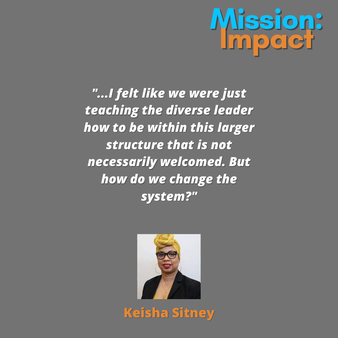 In episode 39, Carol Hamilton looks back at the last year and a half of Mission Impact. Using clips from interviews with Tip Fallon, Nyacko Perry, Carlyn Madden, Kristin Bradley-Bull, Keisha Sitney, Rosalind Spigel, Stephen Graves and Nathaniel Benjamin, she examines:
Learn more about my featured guests:
Click "Read More" for Transcript: 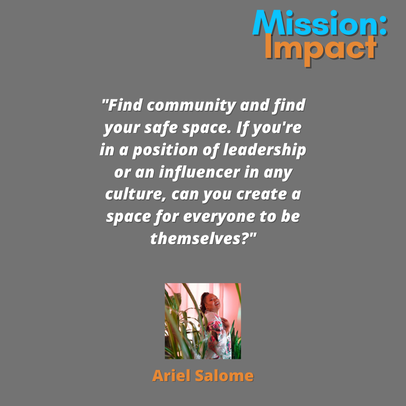 This episode is part of the Culture Fit project that Carol recorded with her son-in-law Peter Cruz. In this episode, Carol, her cohost Peter Cruz, and their guest Ariel Salome discuss:
Guest bio: Ariel Salomé thrives on challenging assumptions and limiting beliefs, reframing challenges into opportunities. She possesses the uncanny ability to constructively disturb the status quo to the point where it opens the floodgates of possibilities, leading to transformation. For the past 18 years, Ariel has served as a training & curriculum designer, DE&I practitioner and group process facilitator. She just returned to California from Washington D.C. where she managed National Science Foundation grant-funded projects in STEM higher education reform, supporting the development of STEM faculty leaders across the nation. Ariel is now known as the “Corporate Healer” as she coaches and develops the next generation of leaders in tech as the PM for Leadership Development at Lyft. Ariel is also the founder and space holder for METANOIA, a spiritual community of practice. Ariel received her BA in Sociology and dialogue facilitation training at Occidental College. She completed ICF comprehensive coaching certification and doctoral-level training in human and organizational development at Fielding Graduate University. Her research and practice include transformative learning, ontological coaching, and the somatic release of intergenerational and racialized trauma. She believes that the world’s greatest problems can find solutions when we show up as fully human and fully divine. Important Links and Resources:
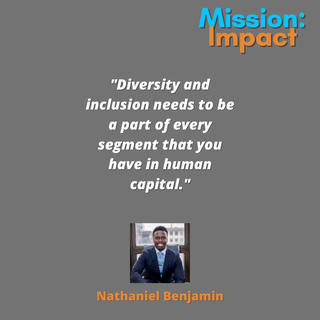 In episode 35 of Mission: Impact, Carol, her cohost, Peter Cruz, and their guest, Nathaniel Benjamin discuss diversity, equity and inclusion and its intersection with human capital management. This episode is a release of a podcast Carol planned to start with her son-in-law and has many transferrable ideas and concepts to the nonprofit sector. We talk about:
Guest bio: Nathaniel Benjamin approaches the space of Diversity and Inclusion as not only a profession, but as a passion that’s taken hold of his life’s work. As a graduate of Johns Hopkins University, University of Baltimore and the University of Maryland Eastern Shore, his educational endeavors led him into a marketable career in Human Resources -- working in the C-suite level --managing workforce planning, strategy, policy and talent management. But to “really” understand how an organization works, he later found that you must understand its people… the diversity of those who make an organization thrive. He brings 17 years of experience as an organizational Change Agent and a D&I Strategist, ready to exceed your organizational needs. Contact: Nathaniel Benjamin:Peter J. Cruz: Click "Read More" for Transcript: 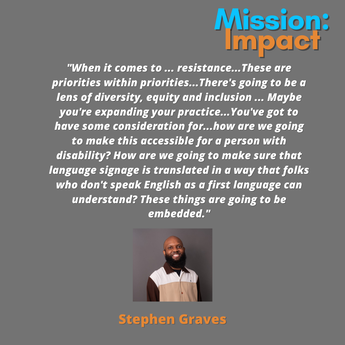 In episode 33 of Mission: Impact, Carol, her cohost, Peter Cruz, and their guest, Stephen Graves discuss diversity equity and inclusion in the health care sector. This episode is a release of a podcast Carol planned to start with her son-in-law and has many transferrable ideas and concepts to the nonprofit sector. We talk about:
Guest bio: Stephen Graves Born in South Carolina and raised in the black Baptist church, Stephen had an insatiable curiosity to understand the South’s nuanced history related to race, his place in that story as a black man, and how the Christian faith could be used as a tool to heal or a weapon to hurt. This curiosity set him on a personal exploration, which turned into a professional journey as he pursued and earned a Master in Health Administration from the Medical University of South Carolina. Throughout his career in healthcare and in diversity, equity and inclusion, he has led initiatives centered on addressing health disparities, improving language access, and increasing cultural humility among teams. He has been fortunate to collaborate with healthcare providers, faith leaders, high school and college students, and business leaders in helping them to create welcoming and inclusive cultures where all can thrive. Resources: Cultural humility: https://www.youtube.com/watch?v=SaSHLbS1V4w Tuskegee Study: https://www.socialworker.com/feature-articles/ethics-articles/The_Tuskegee_Syphilis_Study_and_Its_Implications_for_the_21st_Century/ Racial biases about Black people and pain: https://www.aamc.org/news-insights/how-we-fail-black-patients-pain Guest contact: Stephen Graves: https://www.linkedin.com/in/sggraves/ All In Consulting: https://www.allinconsulting.co/ Peter Cruz: https://www.linkedin.com/in/peterjcruz/ Click "Read More" for Transcript: 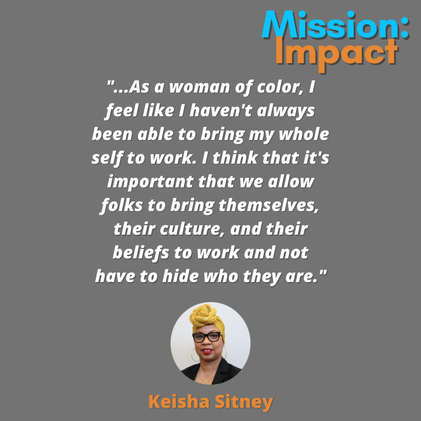 There is a brief discussion of police brutality in this episode around 16 minutes in. In episode 14 of Mission: Impact, some of the topics that Carol and her guest, Keisha Sitney, discussed include: - Why leaders need to be role models for their staff and lead by example - Why organizations need to start with individuals when working on equity - How to build the leadership capacity of people who haven’t traditionally been promoted to leadership roles - Why it is important to not just teach people of color to be like “traditional” white leaders but encourage them develop their own leadership style - How professionals focusing on diversity, equity, and inclusion experience profound fatigue in continually educating people about racism and other forms of oppression.
Keisha Sitney is the Chief People Officer for The Y in Central Maryland and the founder of Golden Key Coaching. She works to ensure the people strategies and resources support and match the strategic priorities of the organization. Keisha is an executive leader who has been with the Y for 30 years, both at the national and regional levels. With in-depth experience in coaching, talent management, strategic visioning and planning, and facilitation, Keisha has served in operational roles at the YMCA of Metropolitan Washington, led the national multicultural leadership development movement as well as served as an internal consultant for C-Suite leaders from Ys across the United States. She holds a Master's Degree in Organization Development from American University and a Bachelor's Degree in Psychology from Howard University. Links:
Click "Read More" for Transcript: |
Archives
April 2024

Grace Social Sector Consulting, LLC, owns the copyright in and to all content in and transcripts of the Mission: Impact podcast, as well as the Mission: Impact blog with all rights reserved, including right of publicity.
|
Telephone301-857-9335
|
info[at]gracesocialsector.com
|
Grace Social Sector Consulting, LLC, owns the copyright in and to all content in, including transcripts and audio of the Mission: Impact podcast and all content on this website, with all rights reserved, including right of publicity.
|